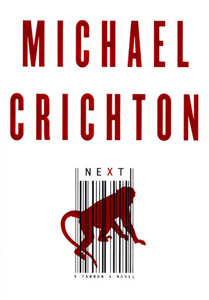“Next” (2006) is Michael Crichton’s most experimentally structured novel, which is appropriate because it’s about genetic experimentation. It has no A-plot, but is instead a series of alternating B-plots. Along with media clippings about genetic experimentation – replacing his usual charts and footnotes – “Next” reads like a scrapbook.
His most absurd novel
So it doesn’t have momentum. Yet it’s a fun book to dive into for bursts at a time. And ultimately everything does coalesce. I wonder if Crichton sort of plotted the book in reverse, knowing that these B-plots would come together via coincidence.
I also wonder if “Next’s” structure is a conscious reaction to his previous book, “State of Fear.” There, he forced an insane A-plot into his largely scholarly exploration of climate change data (and it generally didn’t go over well with critics). So here he skips the A-plot altogether.

“Next” (2006)
Author: Michael Crichton
Genres: Techno-thriller, science fiction, dark comedy
Settings: Various, 2006
It’s appropriate that “Next” is Crichton’s most absurd book, as he’s tackling a field filled with the absurd. For some reason (that the author doesn’t fully explain), the U.S. patent office allows genes to be patented. No other naturally occurring element is allowed to be patented, so it’s ridiculous on the face of it.
Crichton digs further into the insanity via the related issue that corporations are allowed to own a person’s tissues. Corporate intrigue leads to a company needing to re-acquire tissues it owns. Those tissues exist inside a person, so that person and his descendants possess “stolen property” merely by existing.
Different angles
The author approaches genetic issues from three different angles. They seem to contradict, but that kind of explains why this topic is so bizarre to begin with. One is the aforementioned legal strangeness.
Second is the fact that we know as little about genes as we do about the human brain. “The Terminal Man,” which explores mind-control experimentation, now stands as Crichton’s most dated SF novel because humanity has largely abandoned brain research, which was briefly a hot topic in the 1970s. We’ve essentially said “This is way beyond us.”
As he did with “Airframe,” Crichton shows how media spin can be misleading even if a report, strictly speaking, doesn’t contain anything inaccurate. The media often reports on how genes do specific things, but in reality, a gene doesn’t do anything on its own: It interacts with other genes, which also behave on their own.
In the end, we’re talking about a system more complex than a computer program – which, by comparison, is something created by humans, albeit smart ones, and therefore graspable.
Because genes are so complicated, gene therapy almost never works. Crichton speaks of “3 percent” and “1 percent” chances of survival in the cases of two characters with genetic disorders. They try the therapy and die horribly.

Rise of the transgenics
However – and this contradiction isn’t explained by the author – genetic engineering is often successful. After all, corn and dogs (but not corndogs, oddly) are genetically engineered. And while some people fear GMOs – which is part of why such foods are labeled, and why “organic” foods enjoy a slice of the market — their track record of safety is impeccable.
This accounts for “Next’s” third angle, and its most memorable: transgenic beings.
I haven’t mentioned any character names so far because “Next” is a particularly weak character novel. Each person’s role and situation is distinct enough that you won’t be lost, but you won’t remember these people after you close the book.
However, you might remember the almost-people. We get a parrot who not only speaks, but can hold conversations; an orangutan who swears at tourists; and a humanzee (half-chimp, half-human) who goes to school and beats up bullies.
Aside from both of them being SF authors, this is the first time I notice Crichton following in the footsteps of Philip K. Dick, whose creations include a talking dog in “Dr. Bloodmoney.” The people react to the talking animals in a no-nonsense manner; they immediately accept this sea change in reality. It’s funny stuff.
Crichton goes out with a wink
“Next” doesn’t have much emotional depth. For instance, we breeze through the fact of Dave (the humanzee) becoming a member of a family. It’s the same plot as Douglas Preston’s “Jennie,” about a chimp becoming part of a human family. You’ll want to read that book to get a real sense of the joys and tragedies of cross-species living.
“Next” has thrills, but they are played for the dark comedy that comes from these threads converging in the final chapters.
Sadly, this ended up being Crichton’s last completed novel. (He died amid writing “Micro,” which was finished by Richard Preston.)
But it’s actually an appropriate final novel. It makes fun of techno-thrillers (a genre Tom Clancy credits Crichton with inventing) by emphasizing the bizarreness of its chosen SF issue and by using random coincidence rather than logical linkages.
It might actually be the best way to approach the complex and often strange issues surrounding genetics. “Next” isn’t Crichton’s best tech explainer nor his best thriller. Nonetheless, it’s rather genius in its own way.

